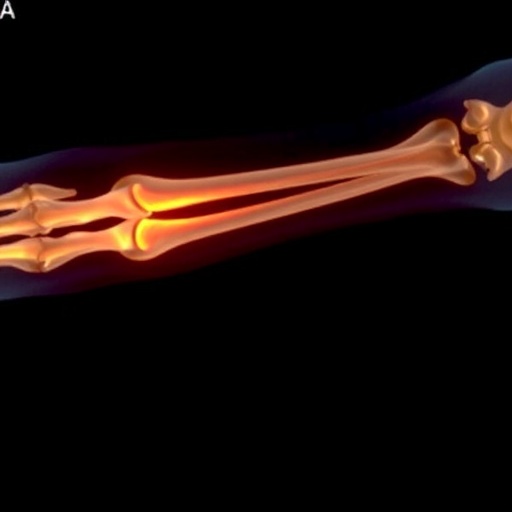In a groundbreaking advancement poised to revolutionize forensic science and legal medicine, researchers have unveiled a novel ultrasonographic scoring system for age estimation based on the developmental transitions from cartilage to bone in forearm bones. Published recently in the International Journal of Legal Medicine, this innovative approach leverages the detailed imaging capabilities of ultrasonography to provide a non-invasive, accurate means of determining age through skeletal maturation markers—a technique long sought after for its potential applications in forensic investigations, human identification, and pediatric medicine.
At the core of this research lies the intricate biological process by which cartilage is gradually replaced by bone, a phenomenon critical in the growth and development of the human skeleton. Traditional age estimation methodologies have predominantly relied on radiographic examinations or physical assessments, often limited by exposure to ionizing radiation or subjective interpretation. Ultrasonography, however, presents a safe, real-time imaging tool that can capture the subtle progression of ossification stages within forearm bones, encompassing key anatomical structures such as the radius and ulna.
The research team, led by Fayed, Seada, and Elkhouly among others, developed a comprehensive scoring system that quantifies the ossification status observed through ultrasonographic imaging. This system meticulously categorizes the transition phases from cartilage to mineralized bone, allowing for a standardized metric that correlates closely with chronological age. By analyzing a representative cohort encompassing a broad age range, the scientists demonstrated that their scoring criteria could reliably predict age with a precision exceeding many existing techniques.
One of the standout aspects of this approach is its adaptability across diverse populations. Since skeletal maturation rates can vary widely due to genetic, environmental, and nutritional factors, the research underscores the importance of using ultrasonographic markers that are universally present and less susceptible to external influences. The forearm bones were strategically selected due to their accessibility and well-documented ossification timelines, making them an ideal region for age estimation that can be deployed in various forensic and clinical scenarios.
Moreover, the ultrasonographic modality offers several practical advantages. Unlike X-rays or CT scans, ultrasonography avoids ionizing radiation, making it especially suitable for repeated assessments in living subjects, such as minors or individuals undergoing legal age verification. The non-invasive nature also facilitates easier adoption in field conditions or resource-limited settings where advanced imaging infrastructure may not be available.
The methodology detailed in the publication reveals that high-resolution ultrasound probes can detect minute changes in the echogenic patterns of growth plates and the surrounding cartilage matrix. These patterns signify ongoing ossification processes, which are then rated by the novel scoring system to yield an age estimate. Intriguingly, the authors highlight clear ultrastructural landmarks identifiable across various developmental stages, enabling consistent interpretation across operators with proper training.
Additionally, the study addresses potential confounding variables such as gender differences in ossification rates, providing sex-specific calibrations within the scoring system. This nuanced approach enhances the accuracy and reliability of the method, catering for differential skeletal maturation patterns observed globally. Consequently, forensic experts and practitioners can apply these findings with greater confidence when issuing opinions on age in medico-legal contexts.
Given the increasing demand for objective and reliable age estimation methods—whether for asylum seekers, juvenile justice, or unidentified remains—this ultrasonographic scoring system offers a timely advancement. Its implementation promises to streamline forensic workflows, providing rapid, reproducible results without compromising subject safety. It could also alleviate ethical concerns surrounding radiation exposure in vulnerable populations requiring repeated assessments.
Looking forward, the researchers envision integrating this ultrasonographic protocol with machine learning algorithms to further automate the scoring process and minimize inter-observer variability. Such integration could facilitate large-scale screening programs and support the digital transformation of forensic imaging. The potential to harmonize imaging data with biometric databases also paves the way for more sophisticated identification systems in forensic science.
This study marks a significant departure from conventional radiological age estimation, harnessing ultrasound’s untapped potential in skeletal biology. By transforming sonographic imaging into a quantitative tool for forensic age assessment, the work embodies a multidisciplinary synthesis of medical imaging, developmental biology, and legal medicine. It also underscores the importance of technological innovation in improving forensic methodologies with far-reaching societal implications.
The detailed findings encourage further validation studies across different ethnicities and clinical settings to establish universally applicable reference standards. Collaborative efforts between forensic centers, pediatric hospitals, and research institutions will be instrumental in refining and expanding the utility of this approach. Ultimately, this could lead to standardized guidelines endorsed by international forensic organizations.
In essence, this pioneering work charts a new course for forensic age estimation, bridging the gap between anatomical development and cutting-edge imaging technology. Its impact may extend beyond forensics, potentially influencing pediatric growth monitoring and orthopedic applications where precise assessment of cartilage-bone transition is critical.
In conclusion, the novel ultrasonographic scoring system for age estimation based on forearm ossification stages offers a safer, more reliable alternative to existing methods rooted in radiography. Its ability to accurately reflect the biological timelines of skeletal maturation positions it as an indispensable tool in legal medicine and beyond. As the forensic community embraces this innovation, it heralds a new era in non-invasive, precise age estimation grounded in the elegant interplay of cartilage and bone revealed through ultrasound.
Subject of Research: The use of ultrasonography for age estimation via cartilage-to-bone ossification in forearm bones employing a novel scoring system.
Article Title: From cartilage to bone: the utility of ultrasonography in age estimation using forearm bones: a novel scoring system approach.
Article References:
Fayed, M.M., Seada, D.A.A., Elkhouly, R.M. et al. From cartilage to bone: the utility of ultrasonography in age estimation using forearm bones: a novel scoring system approach. Int J Legal Med (2025). https://doi.org/10.1007/s00414-025-03623-x
Image Credits: AI Generated
Tags: cartilage to bone transitionforearm bone age estimationforensic science advancementshuman identification techniqueslegal medicine innovationsnon-invasive age determinationossification stages imagingpediatric medicine applicationsreal-time ultrasonography benefitsresearch in age estimation methodsskeletal maturation markersultrasonographic scoring system





